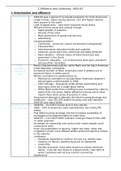1 Affluence and conformity, 1955-63
1 Urbanisation and affluence
Introduction - 1955-63 was a period of increased prosperity for most Americans
- Larger homes, labour-saving devices, cars and higher salaries
than anyone in the world
- Land of opportunity – hard work improves social status
- Affluence led to social and cultural change
o Rapid growth of suburbia
o Decline of the cities
o Mass production of goods and services
o Advertising
- Caused problems
o Conformity – American culture excessively homogenised
o Consumerism
o Advertisements saturated media and roadside
o American youth were less conformist and badly behaved
o Race relations – inferior status of black Americans was
prominent in the South
o Economic inequality – 1/3 of Americans were poor, prevalent
among ethnic minorities
The - Result of government policies, white flight and the black American
changing Great Migration northwards
nature of - Increasing number of black Americans lived in ghettos out of
cities personal choice or white racism
- Whites contributed to ghettoization as
o Restrictive covenants to exclude black Americans despite it
being legally unenforceable in 1948
o 1951 Chicago – thousands of WC whites used looting and
burning to drive out a single black family
o White flight made them unwilling to pay increased tax rates to
assist inner-city areas, higher affluence moving out of cities
meant there were cycles of poverty in cities
- Government attempt to alleviate the black housing shortage was
ineffective – only 325,203 federal housing units built between
1945-65 and many failed
Expansion of - 1948-58 – 13 million homes built in the suburbs
the suburbs - 1960 – 33% of Americans were suburbanites, but mainly MC
whites
- Post WW2 housing shortage and the increased availability of
mortgages encouraged builders to build more
- 1944-52 – 2.4 million WW2 veterans could purchase homes with
no down payment
- Increased car ownership and construction meant people could
commute to work
- Inner city populations of poverty, higher tax rates, noise and
congestion meant more affluent whites preferred spacious homes
in the suburbs
- Levittowns
o Residents expected to conform to rules e.g. weekly lawn
mowing, no fences, washing hung out on weekends
o Uniformity
o Racially exclusive, rocks were thrown at a black American
family, ‘if we sell one house to a Negro family, then 95% of
white customers will not buy into the community’
- Significance
, 1 Affluence and conformity, 1955-63
o Racially sterile, increasing the divide
o Expansion of cities, but decline in conditions
Growing - Post-war economic boom increased job security and disposable
ownership income
and use of - 1955 – 7.9 million cars manufactured
cars - 1945-60 – 133% increase in cars
- 1960 – 73.8 million owned cars
- Demonstrated one’s status and promised mobility and freedom
- Encouraged the desire of the youth to gain independence and
escape parental control
- 1955 – Chevrolets or Fords started at $1,300 (2/5 of the average
family income)
- Roadside motels and restaurants (1960 – 288 McDonald’s) created
thousands of jobs
- Congress authorised the construction of 41,000 miles of interstate
highways
- Significance
o Travelling to work
o Change in culture
o Tourism
o Superiority of American industry
o Teenage culture
o Drive through culture
White collar - 1960 – 35 million service workers, 25 million manuals
jobs - Higher wages
- Blacks didn’t have the qualifications to access these jobs
- Female employment growing 4x as fast as men – WW2 created
employment opportunities
- Significance
o Created growth cycle – jobs increase, more disposable
income, boosted economy
o Encouraged growth of new industries
Consumeris - 1960 – average American family income gave Americans 30%
m and more purchasing power than in 1950
domestic - Suburban Americans rushed to buy cars, labour- saving devices
technology - Essential part of the American dream
- First credit card in 1950 increased consumer demand
- Mass media spread the message through advertising
- Some feared consumerism and runway materialism were
becoming central to the nation’s identity and undermined
traditional American values of hard work and careful money
management
- Economists argued Americans were grossly materialistic and
cared little about the less fortunate
- Teenage consumer became a major factor in the economy
o Spent $1.5 billion on entertainment in 1958
o 1/3 of 18-19 year-old-females were married meaning they
were big spenders on major items
- Significance
o Decline of the inner cities in favour of out of town malls
o Rise of the teenager
o More leisure from labour saving devices meant more time to
spend money
Conclusion: Conclusion: Urbanisation and affluence





